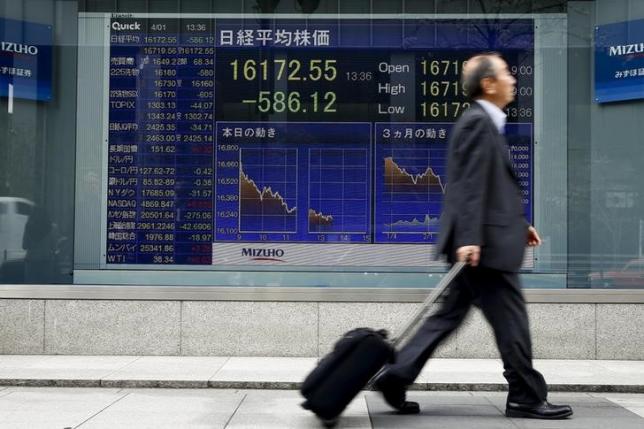Asian shares languish at one-month low ahead of US payrolls data
TOKYO/SINGAPORE: Asian shares wallowed at one-month lows on Friday as investors braced for the US April payrolls report after jobless claims data out earlier raised doubts over the seemingly rosy employment picture.
MSCI's broadest index of Asia-Pacific shares outside Japan .MIAPJ0000PUS fell 0.9 percent, set for a weekly decline of 3.3 percent, the biggest drop in 12 weeks.
Japan's Nikkei .N225 was down 0.7 percent as markets there resumed trading since closing for holidays on Tuesday.
The 0.8 percent slide in China's Shanghai Composite index .SSEC brought gains for the week to 1.1 percent.
Wall Street shares were mixed on Thursday, with the S&P 500 index .SPX slight 0.02 percent drop nevertheless sending it to a three-week low.
"Recent global economic data and some corporate earnings from major Western firms have been lackluster, leading to risk-off trading in markets," said Masahiro Ichikawa, senior strategist at Sumitomo Mitsui Asset Management.
Economists polled by Reuters forecast Friday's payrolls data will show US employers added 202,000 workers in April following a 215,000 increase in March, with the jobless rate holding at 5.0 percent.
But job-related data published over the past couple of days have been softer than market expectations, casting a shadow on expectations of solid job growth.
The number of Americans filing for unemployment benefits rose more than expected last week, posting the biggest gain in more than a year, although its four-week average, often seen as a better gauge of the underlying trend, still stood near a four-decade low.
Another report on Thursday showed a 35 percent surge in planned layoffs by US-based employers last month. Most of the announced job cuts were concentrated in the energy sector, which is reeling from low oil prices.
Yet another compilation, the ADP National Employment Report, showed US private employers added the fewest workers in three years in April, well below economists' expectations.
The dollar index "is likely to rip higher if the non-farm payrolls do not massively miss the market consensus, although the big undershoot in the ADP employment numbers this week has certainly highlighted risks to the downside," Angus Nicholson, market analyst at IG in Melbourne, wrote in a note.
The dollar index recovered from Tuesday's 15-month low of 91.919 to trade at 93.733 .DXY =USD, on track for a 0.7 percent gain for the week.
The euro EUR= held steady at $1.1405, having fallen 0.7 percent on Thursday. It's heading for a weekly drop of 0.4 percent.
The yen, which jumped after the Bank of Japan stood pat on policy last week, changed hands at 107.08 per dollar JPY=EBS, off its 1-1/2-year high of 105.55 set earlier this week. It's set for a 0.6 percent decline for the week.
The Australian dollar AUD=D4 slumped 0.9 percent to$0.7396, close to its two-month low of $0.7394 seen earlier in the session. The currency has been on a downward trend since a rate cut by the Reserve Bank of Australia earlier this week, and is poised for a 2.7 percent loss for the week.
Investors also snatched up bonds, sending the 10-year US Treasuries yield US10YT=RR down to 1.735 percent, the lowest since April 18. It last stood at 1.7488 percent.
The dollar's strength weighed a little on oil prices on Friday, although a raging wildfire in Canada's oil sands region that curbed output flowing mainly to the United States kept losses in check.
US crude's West Texas Intermediate (WTI) futures CLc1 slipped 0.7 percent to $44.01 per barrel, but that followed a gain of 1.2 percent the previous day. They are on track for a 4.1 percent slide for the week.
Brent crude futures LCOc1 fell 0.6 percent to $44.73 per barrel after Thursday's gain of 0.9 percent, set for a weekly decline of 7.1 percent.






